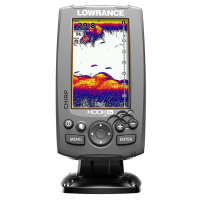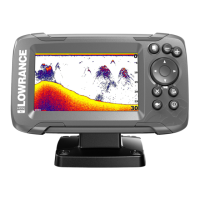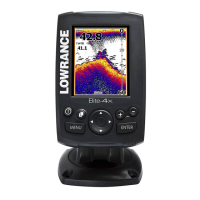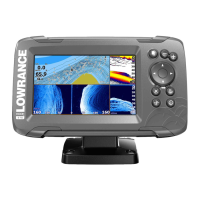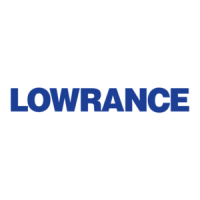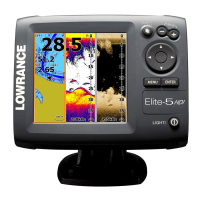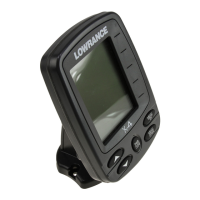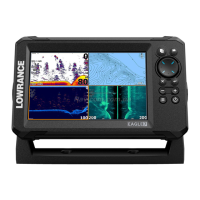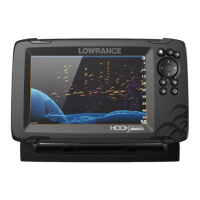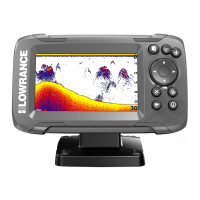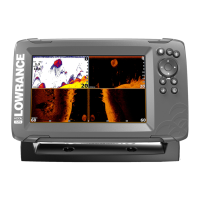Do you have a question about the Lowrance ELITE-4X HDI and is the answer not in the manual?
Describes the function of unit buttons like LIGHT/POWER, KEYPAD, PAGES, MENU, ENTER, and ZOOM KEYS.
Covers turning the unit on/off, adjusting backlight, and muting audio.
Introduces the two types of sonar supported by the unit: Conventional and DownScan.
Explains the initial setup wizard and how to restart it by restoring defaults.
Describes the four available pages and how to select them using the keypad.
Explains how to access menus specific to the DownScan and Sonar pages.
Describes how to access the main settings menu using the MENU button.
Explains how to use the keypad and ENTER key to select menu items and open submenus.
Details the two pre-configured combo pages: Sonar/DownScan and Sonar/DownScan horizontal.
Explains different menu types like scrollbars, on/off features, and dropdown menus.
Covers how dialogs are used for user input and the process for entering text.
Explains how fishing modes provide preset sonar settings for specific fishing conditions.
Covers cursor movement for reviewing sonar history and features enabled in Advanced Mode.
Explains how to enter Standby mode to save power and how to restore unit settings to default values.
Displays the water column moving from right to left on the unit's screen.
Shows the water column moving from right to left and how to overlay DownScan sonar.
Details the two pre-configured combo pages: Sonar/DownScan and Sonar/DownScan horizontal.
Explains how to select and display data on Sonar and DownScan pages and how to customize it.
Describes how to add/remove data and adjust the size and position of overlay data on the screen.
Explains how to review sonar history by moving the cursor left to view past data.
Details how to access the DownScan menu from the DownScan page.
Covers accessing the Adjust menu, contrast settings, Auto Contrast, and Range settings.
Details setting custom ranges, understanding transducer frequencies, and adjusting ping speed.
Introduces options like Noise Rejection, Surface Clarity, Split Zoom, and Color palettes.
Explains how to stop sonar transmission and how to display overlay data on the DownScan page.
Directs users to the Settings menu, referencing "Sonar Settings" on page 27.
Explains how to review sonar history and access the Sonar menu.
Covers making adjustments to Sensitivity and Colorline via the Adjust menu.
Explains Auto Sensitivity, Range settings, and how to set custom upper and lower depth limits.
Details the transducer frequencies (50, 83, 200 kHz) and explains Ping Speed adjustments.
Explains how Noise Rejection uses signal processing to filter out undesired signals.
Describes Surface Clarity, switching to split screen view, and changing display colors.
Details DownScan overlay adjustments, stopping sonar, and displaying overlay data on the Sonar page.
Explains Manual Mode for depth search restriction and adjusting conventional/DownScan settings.
Covers Keel Offset installation, Fishing Modes, and resetting fishing mode settings.
Explains water speed and temperature calibration, resetting water distance, and selecting the transducer type.
Covers adjusting unit settings like language, volume, and enabling advanced features.
Explains how to switch the unit back to its factory default settings.
Provides information about software versions and how to enable and set alarm thresholds.
Allows selection of units for distance, speed, depth, temperature, and bearings.
Details general specifications like case size, display, power requirements, and current drain.
Lists sonar specifications including max depth, frequency, speed, and transducer details.
Provides customer service phone numbers for the US and Canada, including operating hours.
Offers information on ordering accessories and visiting the official website.
Describes the function of unit buttons like LIGHT/POWER, KEYPAD, PAGES, MENU, ENTER, and ZOOM KEYS.
Covers turning the unit on/off, adjusting backlight, and muting audio.
Introduces the two types of sonar supported by the unit: Conventional and DownScan.
Explains the initial setup wizard and how to restart it by restoring defaults.
Describes the four available pages and how to select them using the keypad.
Explains how to access menus specific to the DownScan and Sonar pages.
Describes how to access the main settings menu using the MENU button.
Explains how to use the keypad and ENTER key to select menu items and open submenus.
Details the two pre-configured combo pages: Sonar/DownScan and Sonar/DownScan horizontal.
Explains different menu types like scrollbars, on/off features, and dropdown menus.
Covers how dialogs are used for user input and the process for entering text.
Explains how fishing modes provide preset sonar settings for specific fishing conditions.
Covers cursor movement for reviewing sonar history and features enabled in Advanced Mode.
Explains how to enter Standby mode to save power and how to restore unit settings to default values.
Displays the water column moving from right to left on the unit's screen.
Shows the water column moving from right to left and how to overlay DownScan sonar.
Details the two pre-configured combo pages: Sonar/DownScan and Sonar/DownScan horizontal.
Explains how to select and display data on Sonar and DownScan pages and how to customize it.
Describes how to add/remove data and adjust the size and position of overlay data on the screen.
Explains how to review sonar history by moving the cursor left to view past data.
Details how to access the DownScan menu from the DownScan page.
Covers accessing the Adjust menu, contrast settings, Auto Contrast, and Range settings.
Details setting custom ranges, understanding transducer frequencies, and adjusting ping speed.
Introduces options like Noise Rejection, Surface Clarity, Split Zoom, and Color palettes.
Explains how to stop sonar transmission and how to display overlay data on the DownScan page.
Directs users to the Settings menu, referencing "Sonar Settings" on page 27.
Explains how to review sonar history and access the Sonar menu.
Covers making adjustments to Sensitivity and Colorline via the Adjust menu.
Explains Auto Sensitivity, Range settings, and how to set custom upper and lower depth limits.
Details the transducer frequencies (50, 83, 200 kHz) and explains Ping Speed adjustments.
Explains how Noise Rejection uses signal processing to filter out undesired signals.
Describes Surface Clarity, switching to split screen view, and changing display colors.
Details DownScan overlay adjustments, stopping sonar, and displaying overlay data on the Sonar page.
Explains Manual Mode for depth search restriction and adjusting conventional/DownScan settings.
Covers Keel Offset installation, Fishing Modes, and resetting fishing mode settings.
Explains water speed and temperature calibration, resetting water distance, and selecting the transducer type.
Covers adjusting unit settings like language, volume, and enabling advanced features.
Explains how to switch the unit back to its factory default settings.
Provides information about software versions and how to enable and set alarm thresholds.
Allows selection of units for distance, speed, depth, temperature, and bearings.
Details general specifications like case size, display, power requirements, and current drain.
Lists sonar specifications including max depth, frequency, speed, and transducer details.
Provides customer service phone numbers for the US and Canada, including operating hours.
Offers information on ordering accessories and visiting the official website.
| Display Size | 4.3 inches |
|---|---|
| Resolution | 480 x 272 pixels |
| Display Type | Color TFT LCD |
| Backlight | LED |
| Waterproof Rating | IPX7 |
| GPS | No |
| Chartplotting | No |
| Sonar Type | Broadband and DownScan Imaging |
| Frequency | 83/200 kHz & 455/800 kHz |
| Power Output | 300W RMS |
| Power Output Peak-to-Peak | 2400W |
| Depth Capability Sonar | 1000 ft |
| Depth Capability DownScan | 300 ft |
| Operating Voltage | 12V DC |
| Transducer | HDI Skimmer |
| Operating Temperature | -15°C to 55°C (5°F to 131°F) |
| Storage Temperature | -20°C to +70°C |
